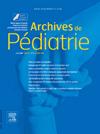Prescription practice and yield of chest radiography in the management of children presenting to the French pediatric emergency department with non-traumatic chest pain
IF 1.3
4区 医学
Q3 PEDIATRICS
引用次数: 0
Abstract
Objectives
Chest pain is a common symptom in pediatric emergency department. The causes are mostly benign without any sign on chest x-ray (CXR). However, CXR is one of the most ordered tests in this situation. Our main objective was to assess the current management of CXR by physicians in this context, according to the algorithm proposed by the French Society of Pediatrics (FSP).
Materials and methods
We conducted a retrospective study in two French pediatric emergency departments. We reviewed the medical records of children who presented with chest pain between 2018, July 1rst to 2021, July 31th. We collected data from history and clinical examination. The prescription of CXR and its interpretation were collected.
Results
Overall, 599 children were enrolled. The algorithm was followed in 57,1 % of cases, and 8,2 % of abnormal CXR were noted. On univariate analysis, medical history with a significant OR greater than 2 included cardiological history (as defined by FSP), neoplasia, pneumonia and sickle cell disease. Right lateralized pain, pain that worsens with respiration, fever and cough were also symptoms significantly associated with an abnormal CXR result. On physical finding, tachycardia, tachypnea, abnormal cardiac and pulmonary clinical examination (as defined by the FSP) were significantly associated with pathological CXR. However, the multivariate logistic regression model could not be carried out due to too many significant variables in univariate analysis, and too few number of abnormal CXR reported.
Conclusion
CXR remains the cornerstone of chest pain management in pediatric emergencies, even though the rate of abnormal CXR appears low. The appropriateness of CXR prescribing can be improved by guidelines focusing on the clinical etiologies of chest pain visible on CXR. A similar prospective study may identify risk factors for pathological CXR and clarify the decision tree for the indication of CXR in chest pain.
法国儿科急诊室在处理因非外伤性胸痛前来就诊的儿童时的处方做法和胸片检查率。
目的:胸痛是儿科急诊的常见症状。其原因多为良性,胸部 X 光片(CXR)上无任何征象。但在这种情况下,CXR 是最常被要求进行的检查之一。我们的主要目的是根据法国儿科学会(FSP)提出的算法,评估目前医生在这种情况下对 CXR 的处理:我们在法国两家儿科急诊室开展了一项回顾性研究。我们查阅了 2018 年 7 月 1 日至 2021 年 7 月 31 日期间因胸痛就诊儿童的病历。我们收集了病史和临床检查数据。我们还收集了胸透处方及其解释:共有 599 名儿童入选。57.1%的病例遵循了该算法,8.2%的病例发现了异常气管造影。单变量分析显示,心脏病史(根据 FSP 定义)、肿瘤、肺炎和镰状细胞病等病史的 OR 值大于 2。右侧疼痛、呼吸时疼痛加剧、发热和咳嗽也是与 CXR 结果异常显著相关的症状。在体格检查中,心动过速、呼吸过速、心肺临床检查异常(根据 FSP 定义)与病理 CXR 显著相关。然而,由于单变量分析中的显著变量过多,以及报告的异常 CXR 数量过少,多变量逻辑回归模型无法进行:结论:尽管 CXR 异常率似乎较低,但 CXR 仍是儿科急诊胸痛处理的基石。可以通过关注 CXR 可见胸痛的临床病因的指南来提高 CXR 处方的适当性。类似的前瞻性研究可确定病理性 CXR 的风险因素,并明确胸痛时 CXR 适应症的决策树。
本文章由计算机程序翻译,如有差异,请以英文原文为准。
求助全文
约1分钟内获得全文
求助全文
来源期刊

Archives De Pediatrie
医学-小儿科
CiteScore
2.80
自引率
5.60%
发文量
106
审稿时长
24.1 weeks
期刊介绍:
Archives de Pédiatrie publishes in English original Research papers, Review articles, Short communications, Practice guidelines, Editorials and Letters in all fields relevant to pediatrics.
Eight issues of Archives de Pédiatrie are released annually, as well as supplementary and special editions to complete these regular issues.
All manuscripts submitted to the journal are subjected to peer review by international experts, and must:
Be written in excellent English, clear and easy to understand, precise and concise;
Bring new, interesting, valid information - and improve clinical care or guide future research;
Be solely the work of the author(s) stated;
Not have been previously published elsewhere and not be under consideration by another journal;
Be in accordance with the journal''s Guide for Authors'' instructions: manuscripts that fail to comply with these rules may be returned to the authors without being reviewed.
Under no circumstances does the journal guarantee publication before the editorial board makes its final decision.
Archives de Pédiatrie is the official publication of the French Society of Pediatrics.
 求助内容:
求助内容: 应助结果提醒方式:
应助结果提醒方式:


